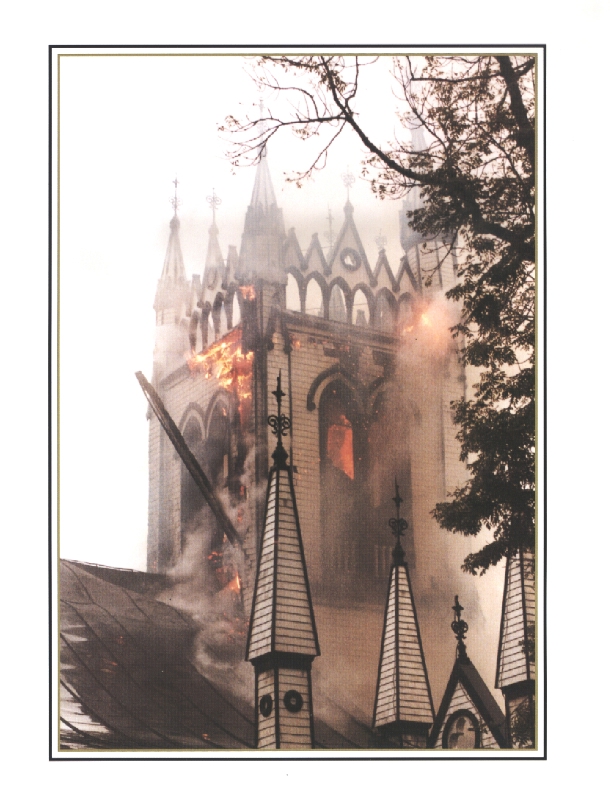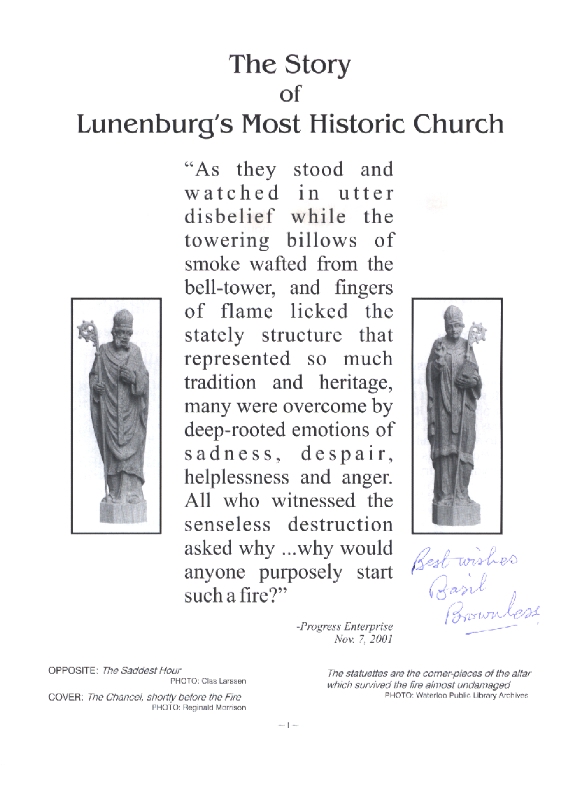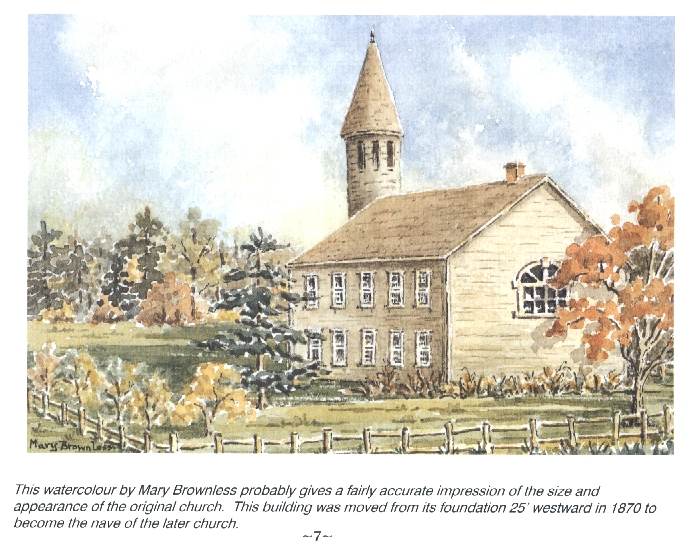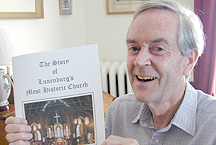The 250-Year History of St. John's Anglican Church, Lunenburg, Nova Scotia
by Basil Brownless
Lunenburg, 2002




Water-colour by Mary Brownless, 2002
The first church which was 40 x 60 feet, was moved to become the nave of the 1870 reconstruction.
This artist's impression is based on these measurements; allowance has been made for space for the gallery and flat ceiling, and East end window, which would have been below the ceiling. The original ink sketch does not appear to have the right proportions.
Susan Corkum-Greek
LUNENBURG - The author of a newly-released book on Lunenburg's Most Historic Church admits its next chapter may well be one of the most exciting. Over the next 18 months, St. John's Anglican Church, gutted in a Halloween night fire, will be rebuilt and restored. The work will cost about $6 million and Basil Brownless hopes his fundraising contribution - a 36-page pictorial history - will help in that endeavour. A retired journalist and educator, Mr. Brownless was already pulling together materials for a church history to have been launched in conjunction with St. John's 250th anniversary next year, when the tragic fire occurred. That event gave the project a different timeline. All of a sudden, "it seemed better to put it out early and use it as a fundraising tool," he says.
Still, Mr. Brownless insists his primary motivation in producing a history was to set the record straight on a number of mistruths long circulating in the community. "When I first came here [in the early 1990s] I was appalled at the inaccurate rubbish being told to tourists not only at the church but all over the town," he says. These included the long-held belief that the church was established by royal charter - not so, says the book - or that its roof was built like a ship's hull. Mr. Brownless recalls this latter myth was even sermonized from the pulpit. However, he assures readers it is simply an example of the hammer-beam construction style common to cathedrals throughout England. In fact, he quickly produces a newspaper clipping, showing the coffin of the Queen Mother as it lay in state at Westminster Abbey. "You see the roof is the same," he says.
 |
Basil Brownless, author of the newly-released Story of Lunenburg's Most Historic Church: the 250-year History of St. John's Anglican Church, says he wanted to set the record straight on a number of long-held mistruths surrounding the church while also raising money for its rebuilding. Susan Corkum-Greek photo |
The son of a British clergyman, Mr. Brownless has served as the chairman of St. John's heritage committee for most of the past decade. During that time, he says he's worked to verify, or in some cases debunk, the historical information associated with the church so as to provide interesting and accurate tours for summer visitors. "To me, anything associated with a church should be scrupulously honest," he says. "I mean, if a science or math teacher was teaching something in the school that was untrue, you'd be offended, wouldn't you?"
Mr. Brownless also organized a collection of historical photographs, put to good use in the new publication. "We [the church wardens and himself] decided it would be better to have a short pictorial than a great heavy volume," he says of the book, which combines modern-day photography, particularly of the 2002 fire, along with the old black and white prints. There are also a number of sketches, as well as a watercolour, provided by his wife, artist Mary Brownless, that show the various features and construction stages of the church.
The book, Mr. Brownless' second this year - the first, Some Thoughts on the Rebuilding of St. John's Anglican Church, he produced independently as a means of highlighting some of the finer points of the church's architecture and ways they could be improved through the restoration process - is written in a tight, journalistic style, making it easily readable while still entertaining. "It's really very much a history of the town, as well as the church," says the author, who looks forward to the prospect of writing an additional chapter, recounting the restoration, in a couple of years' time. For now, The Story of Lunenburg's Most Historic Church: the 250-year History of St. John's Anglican Church, is available at the restoration project gift shop on Cumberland Street. It was printed by Best Print.
© 2008 Lighthouse Publishing Ltd.
Lisa Brown
LUNENBURG - The Town of Lunenburg will be without its most notable historian following the death of Basil Brownless, December 21 at Fisherman's Memorial Hospital. Born in England in 1925, Mr. Brownless was a veteran who served with the Royal Navy during the Second World War. He followed his military stint with a 20-year career as a journalist and newspaper editor, before turning his attention to the field of education. Mr. Brownless studied at Hereford Teacher's College and later at Acadia University after moving to Canada with his wife, Mary, and their two children in 1970. He taught in a number of schools in both the Annapolis Valley and along the South Shore, before finally settling in Lunenburg in the early 1990s.
Upon his arrival, Mr. Brownless took an avid interest in the historical aspect of the town, particularly St. John's Anglican Church where he served as warden as well as on the heritage committee. He also dedicated himself to the restoring of Koch-Solomon House, the circa 1785 home which he and his wife purchased in 1995. It was, however, his association with the famous church that gained Mr. Brownless the greatest notoriety, particularly following the devastating fire that nearly destroyed the structure in 2001.
In the early 1990s, he had compiled a book of over 200 melodies which had been arranged specifically for play on the church's carillon bells. Only one copy of the book, created to honour long-time ringer Edson Tanner, existed, and it was stored in the church's bell tower. Miraculously, it survived the inferno intact. The bells, which Mr. Brownless helped ring during the summer months, were not as fortunate. Three were destroyed to the point of needing to be totally recast, while the other seven required restoration work. Also escaping destruction in the fire was a display which Mr. Brownless had created to inform tourists of the church's colourful history.
 |
Basil Brownless, who died December 21, was a long-time member of St. John's Church heritage committee and also served as warden of the church. File photo |
Recounting the story from the time of the church's original construction in 1754, the display also notes the significance of the church as the second oldest protestant parish in the country. Placed in a tin suitcase and tucked under a pew, it, too, was undamaged. When the fire occurred, Mr. Brownless had already been working on a book chronicling the history of the church which he was planning to have completed by the 250th anniversary of its founding which will be celebrated in 2004. The fire prompted him to speed up his work, for, as he said on the book's release last summer, "It seemed better to put it out early and use it as a fundraising tool." Titled The Story of Lunenburg's Most Historic Church, the work gave Mr. Brownless the opportunity to debunk a number of myths that had been circulating about St. John's.
In what he described as "inaccurate rubbish," Mr. Brownless recounted how the church wasn't established by royal charter as was often believed. Another popular, but false, theory that he exposed is that the roof of the building was built to copy the shape of a ship's hull. He pointed out it was merely an example of a style common in English Cathedrals known as hammer beam construction. Mr. Brownless also compiled a collection of photographs, both pre- and post-fire, and included sketches drawn by his wife featuring the church as it was in various stages of construction. He said at the book's release that he hoped to write additional chapters in a couple of years, outlining the completion of the restoration. Mr. Brownless wrote a second book, Some Thoughts on the Rebuilding of St. John's Anglican Church, in which he highlighted the finer points in the building's architecture and how they could be improved upon during the restoration process.
He was also responsible for the restoration of a mural on the wall of the Lunenburg church's parish hall, as well as the installation of a pipe organ at St. Stephen's Anglican in Chester, one of a number of churches where he served as organist and choir director.
Although he mourned the loss of St. John's, Mr. Brownless maintained a positive attitude toward the rebuilding project and the church's future. In a letter to this newspaper after the fire, Mr. Brownless wrote that "Our disaster will, in time, become our opportunity."
Mayor Laurence Mawhinney called Mr. Brownless a man with a great love of history "whose contribution was varied over many different areas. "I think [he] has given a rich legacy to the community in that regard," he said.
Mr. Brownless is survived by his wife, Mary, son, Edmund and daughter, Ruth. A memorial service was held at Zion Lutheran Church in Lunenburg on Friday, December 27.
© 2008 Lighthouse Publishing Ltd.
Basil Brownless